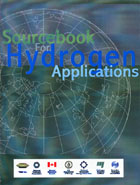
 Enter HyVIEW™
Enter HyVIEW™
Quick Links
| Hydrogen Safety Issues Hydrogen Safety Measures Comparisons Codes & Standards |
Comparison
Comparing hydrogen with other fuels can help evaluate its relative safety. In many cases, hydrogen is much less a problem while, in others, it may be more problematic. Hydrogen has about three times the energy content of gasoline, propane or methane weight per unit weight. Due to its low density, however, if we compare volumes instead of masses, a liter of room temperature hydrogen at atmospheric pressure has 2610 times less energy than gasoline, 6.70 times less than propane, and 2.66 times less than methane. The great advantage of gasoline lies not in its energy content per unit of mass, which is much lower than hydrogen and pretty much the same as propane or methane, but in its conveniently high density. Finding ways to efficiently store hydrogen in a small volume is one of the most active areas of research in hydrogen technologies today. Hydrogen has larger flammability and wider detonation limits than gasoline or methane. Although its detonation limits are large, it is difficult to ignite hydrogen in air if it is unconfined. A hydrogen explosion usually requires turbulence and a restricted volume, such as an enclosed areas or a tube. At stochiometry, which occurs when the mixture of hydrogen and air is such that all the fuel and all the oxygen is consumed after ignitiona, a mixture of hydrogen and air requires much less energy to ignite than either of these fuels. This occurs when the air-hydrogen mixture is composed of 28% hydrogen molecules. However, below 10%, the ignition energy of hydrogen is similar to that of methane. Hydrogen is less dense than methane or gasoline, and has a lower viscosity. This implies that it will tend to disperse more quickly. Hydrogen, or its combustion products is less toxic than methane or gasoline. The hydrogen flame has a low emissivity. The adiabatic flame temperature is similar to that of most hydrocarbon fuels. Overall, thermal hazards from hydrogen flames are, therefore, less critical than hydrocarbon fuels.
Setting Appropriate Standards — A Quest for Safety
There are both technical and economic components of the safety question. The cost of zero risk and complete reliability is infinite. Thus, we have to determine where the trade-offs are and much of this is determined through experience embodied in standards. Standardization not only helps ensure safety; it also facilitates international trade in hydrogen as an energy commodity and in the products, services and systems that are being commercialized to make hydrogen generally available. The International Standards Organization defines a standard as:
"A concise statement of a set of requirements to be satisfied by a product, a material or a process -- indicating, wherever appropriate, the procedure by means of which it may be determined whether the requirements given are satisfied."
National or international organizations such as the American National Standards Institute, the Standards Council of Canada and the International Standards Organization prepare standards through a consensus process. Committees and working groups with representatives of stakeholders, such as government, industrial manufacturers and operators, meet to write the standards. Or, they may be professional associations such as the American Society for Mechanical Engineering with its Boiler and Pressure Vessel Code and the Compressed Gas Association, the American Society for Testing and Materials which develops and publishes numerous standards and recommended practices. Other relevant codes are the various national and regional fire, building and electricity codes as well as regulations pertaining to the transportation of dangerous goods. Furthermore, recommended practices issued by various manufacturers associations (AGA, CGA) should be followed. When safety practices and standards become well-established, they may become adopted as legally binding through legislation as regulations.

